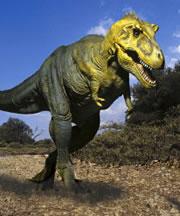 Tyrannosaurus rex may have had the genetic 'lightness' to permit flight, long before their descendents took to the skies.NHPA
Tyrannosaurus rex may have had the genetic 'lightness' to permit flight, long before their descendents took to the skies.NHPAA study of dinosaur genomes hints that the early evolution of a smaller genome might have been necessary for later vertebrates to take to the skies.
Birds have long been known to have much smaller genomes than mammals and reptiles living on the ground. And a small genome has been linked to both small cell size and high metabolic rate: the lower volume-to-surface ratio of small cells, which don't have much DNA to pack inside, can allow for faster transport of nutrients and signals across the membrane. Thus, some suggest that the energetic demands of flight require birds to have a 'light' genome.
But which came first: flying birds or the smaller genome?
To find out, Chris Organ from Harvard University in Cambridge, Massachusetts, and his colleagues estimated the genome sizes of the dinosaur ancestors of birds.
To get genetic information out of fossils that are hundreds of millions of years old, the team looked at the size of the bone cells. First, they established the relationship between the size of the bone cells and that of the genome in 26 living species of vertebrate, from fish to birds. Using sections of fossilized bone, they then measured the size of the pockets in which the bone cells would have sat in 31 species of extinct land-bound dinosaurs. From that they could estimate the size of the bone cells and, therefore, the size of the dinosaurs' genomes.
This innovative approach "opens a lot of doors for new research" says vertebrate palaeontologist Peter Makovicky at the Field Museum in Chicago, Illinois.
The team's results show that dinosaur genomes shrank dramatically within the saurischian lineage some 60 million years before the first birds evolved, says Andrew Shedlock, also from Harvard University and a co-author of the study — published in this week's Nature1. It seems that great beasts such as Tyrannosaurus rex may at least have had the genetic 'lightness' to permit energetically demanding flight, long before their descendents took to the skies.
Stripped down for flight
It's hard to tell exactly when the genome began to shrink. The authors pin it down to a broad period between 250 and 230 million years ago. But the dinosaur fossil record is spotty, and not all fossils have been sliced up for study, notes Makovicky. "But the overall result — that a change in genome size preceded the evolution of birds — looks pretty solid," he says.
The authors also found that the DNA of living vertebrates hints that the flying species have simply lost a lot of the repetitive sequences in their genome. They speculate that an active process of chopping out baggage DNA might be needed to keep the genome trim.
Although the study suggests that small genomes came before flight evolved in birds, it also seems to be true that flying keeps cells and genomes small. Modern birds that have adopted a more sedentary lifestyle, such as ostriches, have larger genomes than strong fliers. Perhaps the active process of chucking out redundant DNA was no longer selected for in these animals. An interesting next step would be to look at the genome sizes of the flying dinosaurs, the pterosaurs, which evolved flight independently of birds, says Organ.
Quite a few traits once thought to have evolved in birds — including feathers, nesting and parental care — have now been shown to have originated in dinosaurs, long before birds arrived on the scene.
Visit our newsblog to read and post comments about this story.
-
References
- Organ C. L., et al. Nature, 446 . 180 - 184 (2007). | Article |
